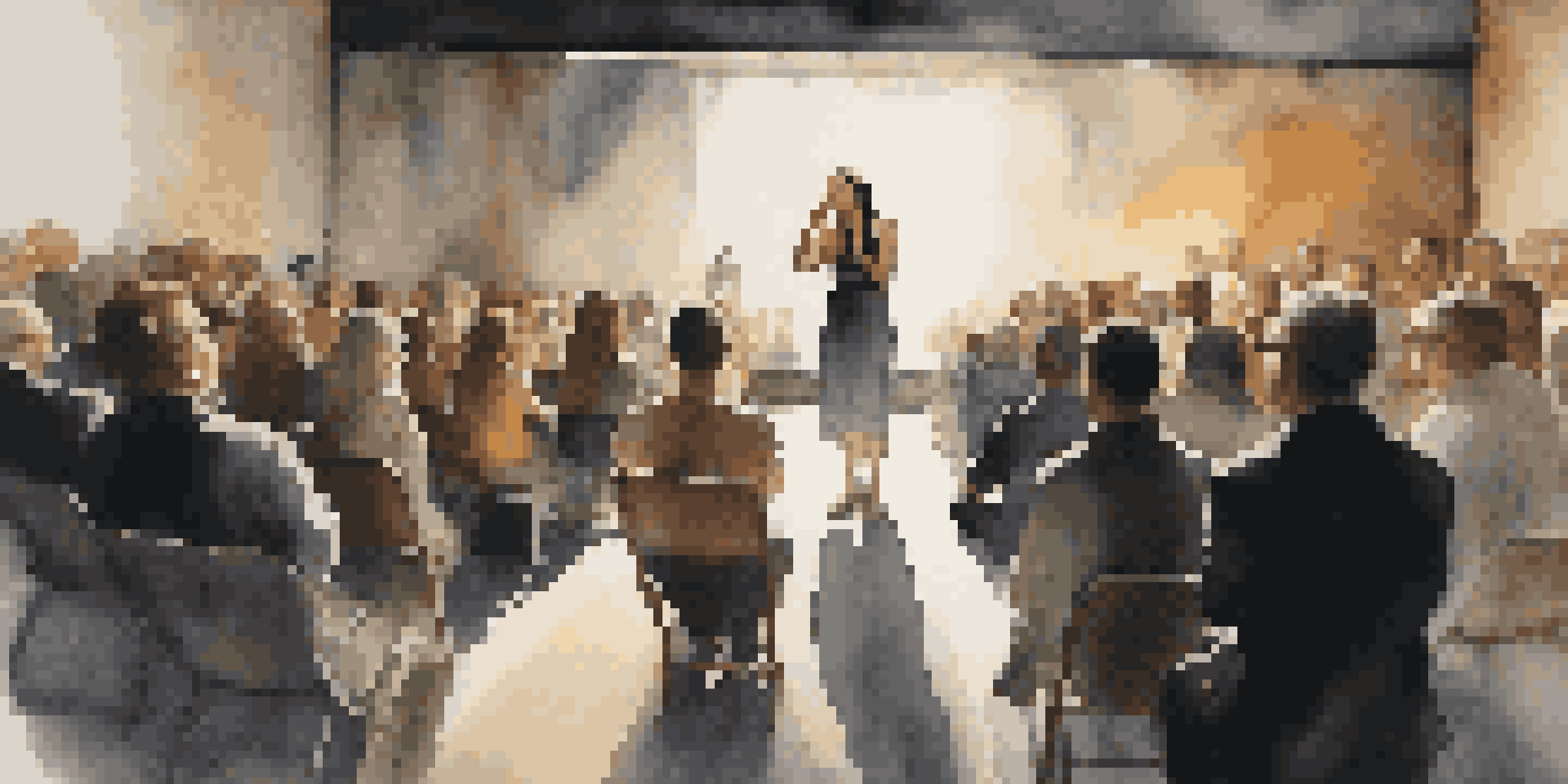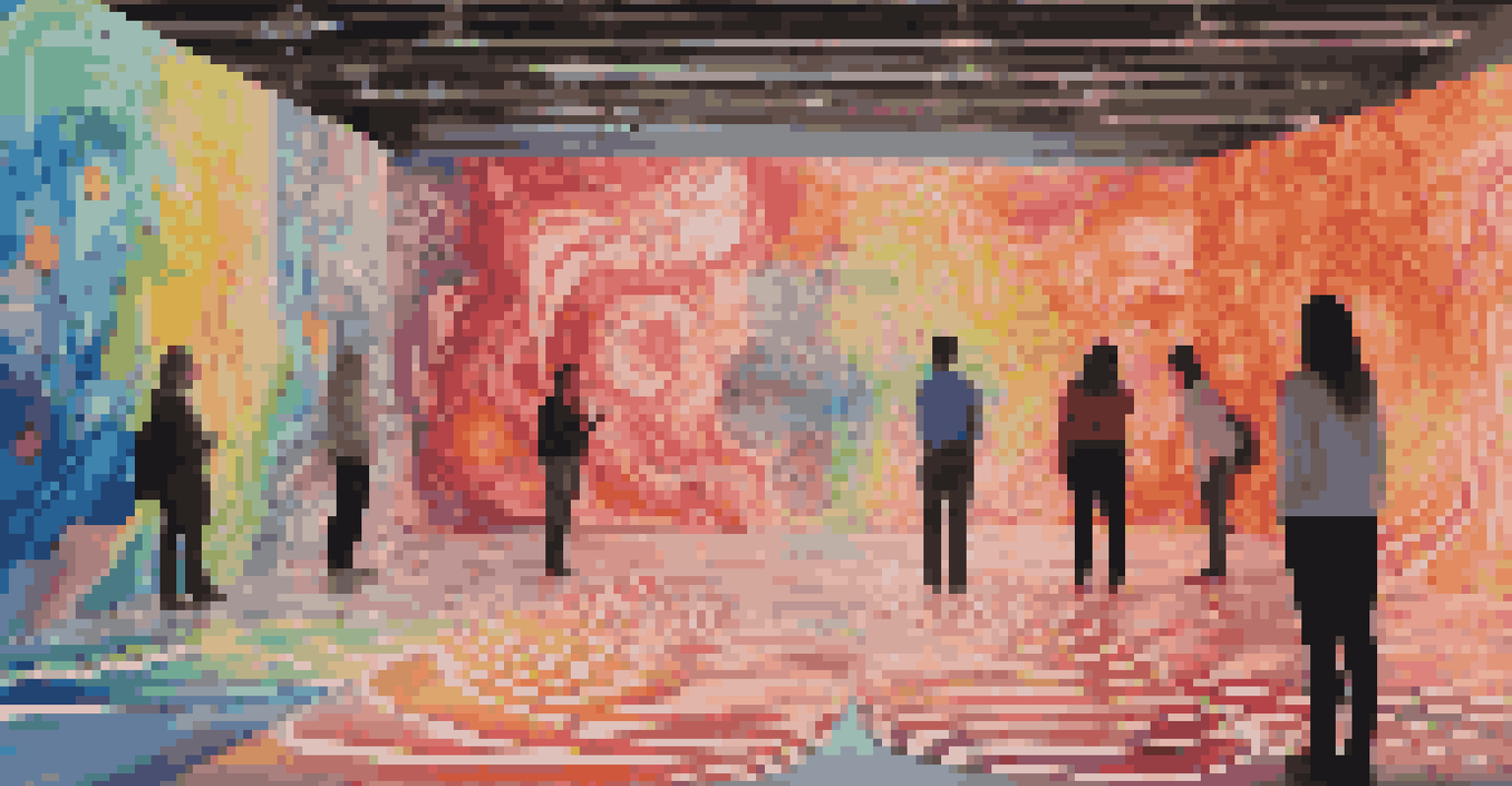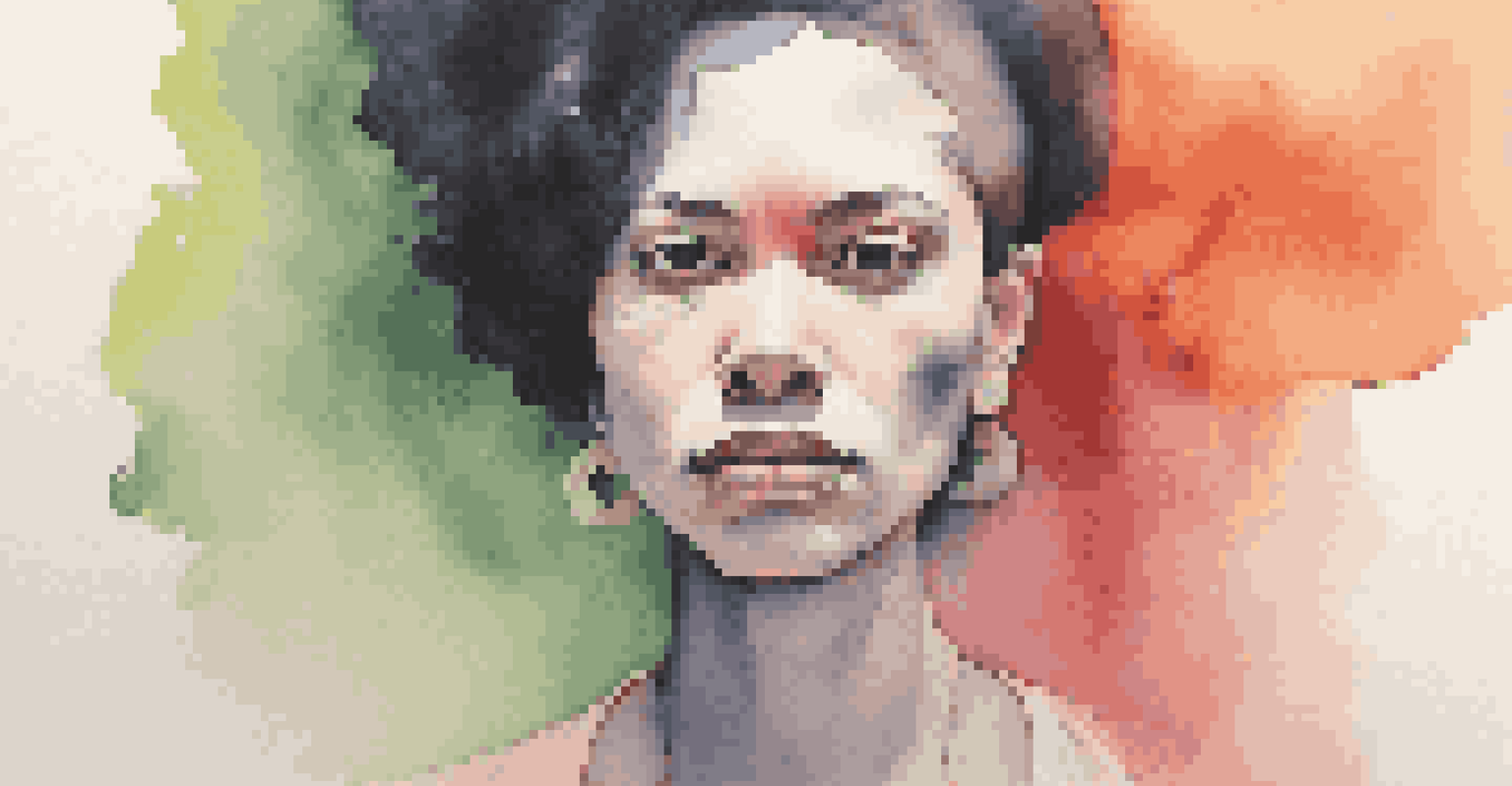The Body as a Site of Resistance in Contemporary Art

Understanding the Body in Contemporary Art
The body has always been a central theme in art, but in contemporary settings, it takes on a new significance. Artists use the body as a canvas to express personal and political narratives, reflecting the complexities of identity in today's world. This exploration goes beyond mere representation; it becomes a powerful form of resistance against societal norms and expectations. By examining the body, artists challenge viewers to rethink their perceptions of race, gender, and sexuality.
Art should comfort the disturbed and disturb the comfortable.
For instance, consider the work of artists like Marina Abramović, who pushes the boundaries of performance art through her physical endurance. Her pieces often highlight vulnerability and strength, inviting the audience to engage with their own emotional responses. By placing the body at the forefront, these artists create a dialogue about the lived experiences of marginalized groups, making the body a site of both struggle and resilience.
Ultimately, contemporary art transforms the body into a medium for activism, allowing artists to confront and dismantle oppressive structures. This shift not only challenges traditional artistic conventions but also fosters a deeper understanding of the human experience. Through this lens, the body becomes a potent symbol of resistance, urging viewers to reflect on their own roles within the larger societal context.
Historical Context: The Body's Evolution in Art
The representation of the body in art has evolved significantly over centuries, shaped by cultural, political, and technological changes. In earlier periods, the body was often idealized, reflecting societal norms of beauty and virtue. However, as modernity set in, artists began to subvert these ideals, using the body to convey raw emotion and social critique. This historical evolution sets the stage for contemporary practices where the body is not just depicted, but actively engaged in resistance.

In the 20th century, movements like Dada and Surrealism questioned traditional aesthetics and the very notion of art itself. Artists like Francis Picabia and Salvador Dalí introduced the idea of the body as a site of absurdity and disruption, paving the way for future explorations of identity and embodiment. Their work laid the groundwork for later artists who would harness the body as a tool for social commentary, particularly in relation to issues of race, gender, and sexuality.
Body as Art: Resistance and Identity
Contemporary artists use the body to challenge societal norms, reflecting personal and political narratives related to identity.
This historical context underscores the importance of understanding the body as a dynamic and evolving symbol in art. By tracing its journey through different artistic movements, we can appreciate how contemporary artists draw on this legacy to challenge prevailing narratives. The body, once a passive subject, now emerges as an active participant in the ongoing conversation about identity and resistance.
The Role of Performance Art in Body Politics
Performance art has become a vital medium through which artists explore body politics and resistance. By engaging their own bodies in real-time, performers create a visceral connection with the audience, making the message more immediate and impactful. This form of art often challenges societal norms surrounding the body, pushing viewers to confront uncomfortable truths about power dynamics and privilege. The act of witnessing becomes an integral part of the experience, as audiences are invited to reflect on their own perceptions.
The body is a site of resistance, a place where identity and politics converge.
Artists like Yoko Ono and Chris Burden have utilized performance to engage with themes of violence, identity, and vulnerability. Ono's 'Cut Piece,' for instance, invites audience participation in a way that raises questions about consent and objectification. Burden's 'Shoot' starkly confronts the relationship between the body and societal violence, forcing viewers to grapple with their own complicity in such narratives. Through these performances, the body becomes a site of both confrontation and dialogue.
As performance art continues to evolve, it remains a powerful tool for exploring the complexities of identity and resistance. By placing the body at the center of their work, artists not only reflect on societal issues but also invite audiences to engage in meaningful conversations. This dynamic interplay between performer and viewer highlights the potential of performance as a catalyst for change, making it an essential aspect of contemporary art.
Exploring Gender and Sexuality through the Body
Contemporary artists often use the body to explore themes of gender and sexuality, challenging traditional binaries and societal expectations. By embracing fluidity and ambiguity, these artists create space for diverse identities to be expressed and celebrated. Works that highlight the body's relationship to gender often confront issues of representation, visibility, and the politics of desire. This exploration not only empowers marginalized voices but also invites broader discussions about the nature of identity itself.
Take, for example, the work of artist Cassils, who uses their body to blur the lines between gender presentation and identity. Through performance and sculpture, Cassils challenges viewers to reconsider their preconceived notions about masculinity and femininity. Similarly, artists like Zanele Muholi focus on the experiences of Black LGBTQ+ individuals, using photography to document and elevate their stories. In doing so, they create a powerful narrative that resists erasure and celebrates diversity.
Performance Art's Impact on Society
Performance art creates a visceral connection, allowing artists to confront uncomfortable truths about power dynamics and privilege.
By engaging with the body as a site of resistance, these artists encourage audiences to reflect on their own understandings of gender and sexuality. This critical examination allows for a more inclusive and nuanced dialogue about identity, fostering empathy and understanding. Ultimately, the body serves as a canvas for exploring the complexities of human experience, making it an essential aspect of contemporary artistic expression.
Race, Identity, and the Body in Contemporary Art
The body is a potent symbol for exploring race and identity in contemporary art, serving as a means of resistance against systemic oppression. Artists from diverse backgrounds utilize their bodies to confront stereotypes, challenge cultural narratives, and reclaim their stories. This work often highlights the intersectionality of race, gender, and sexuality, illustrating how these identities shape individual experiences. Through their art, these creators invite viewers to confront uncomfortable truths about race and privilege in society.
Artists like Kehinde Wiley and Kara Walker employ their work to engage with themes of race and representation. Wiley's vibrant portraits reimagine classical European painting through the lens of Black identity, challenging viewers to reconsider historical narratives. Walker, on the other hand, uses silhouettes to explore the complexities of race and gender in American history, often addressing the legacy of slavery and its ongoing impact. Both artists harness the body as a site of resistance, pushing back against dominant cultural narratives.
By centering the body in discussions of race and identity, contemporary artists create a space for dialogue and reflection. This exploration not only fosters greater understanding but also empowers marginalized voices within the art world. As audiences engage with these works, they are prompted to examine their own positions within the societal fabric, ultimately contributing to a broader conversation about race, identity, and resistance.
The Body in Digital Art: New Frontiers of Resistance
In the digital age, the body continues to serve as a site of resistance, particularly within the realm of digital art. Artists are harnessing technology to explore new representations of the body, often challenging traditional notions of identity and embodiment. Virtual reality, augmented reality, and digital installations allow for innovative expressions of the body that transcend physical limitations. This evolution opens up new avenues for dialogue and engagement with issues of identity, representation, and resistance.
For instance, artists like Rafael Lozano-Hemmer create interactive installations that respond to the viewer's body, blurring the lines between the physical and digital realms. Such works invite audiences to consider their own identities in relation to technology, exploring how digital landscapes shape our understanding of self. Additionally, social media platforms have become vital spaces for artists to showcase their work and engage with global audiences, allowing for a democratization of art and resistance.
Digital Art Redefines Body Representation
In the digital age, artists leverage technology to explore new representations of the body, fostering dialogue around identity and resistance.
As digital art continues to evolve, it challenges conventional boundaries of the body and identity. This innovation not only enhances the possibilities for artistic expression but also encourages critical conversations about representation in the digital age. By embracing technology, contemporary artists transform the body into a multifaceted site of resistance, pushing the limits of how we understand and engage with identity.
The Future of the Body as a Site of Resistance
As we look to the future, the body will undoubtedly remain a powerful site of resistance in contemporary art. Artists continue to push boundaries, exploring new mediums and technologies to express their narratives and challenge societal norms. The conversations surrounding identity, race, gender, and sexuality will evolve, reflecting the ever-changing landscape of our society. This ongoing exploration invites us all to engage with the complexities of the human experience and the ways in which art can serve as a catalyst for change.
Moreover, as global movements for social justice gain momentum, the role of the body in art will become increasingly significant. Artists will continue to use their work to address pressing issues, such as climate change, human rights, and systemic oppression. By centering the body in these discussions, they create a compelling narrative that resonates with audiences on a personal level, fostering empathy and understanding.

In conclusion, the body as a site of resistance in contemporary art is not just a fleeting trend but a vital aspect of artistic expression. It challenges us to reconsider our perceptions and engage with the complexities of identity and society. The future promises to bring even more innovative and diverse voices to the forefront, ensuring that the body remains a powerful symbol of resistance and resilience in the art world.